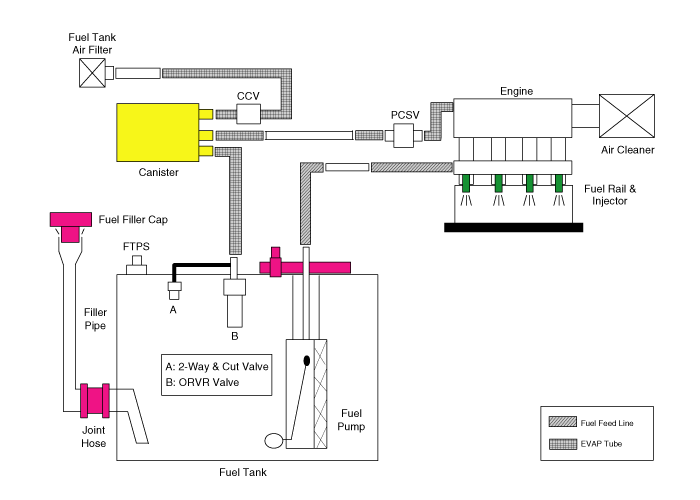 Kia Soul: Schematic Diagram
Kia Soul: Schematic Diagram
Kia Soul 2014-2019 PS Service Manual / Emission Control System / Evaporative Emission Control System / Schematic Diagram

Canister
The Canister is filled with charcoal and absorbs evaporated fuel vapor
from the fuel tank. The gathered fuel vapor in canister is drawn into the intake
manifold by the ECM/PCM when appropriate conditions are set.
Purge Control Solenoid Valve (PCSV)
The Purge Control Solenoid Valve (PCSV) is installed in the passage connecting
the canister to the intake manifold. It is a duty type solenoid valve and is
operated by ECM/PCM signal.
To draw the absorbed vapor into the intake manifold, the ECM/PCM will
open the PCSV, otherwise the passage remains closed.
Fuel Filler Cap
A ratchet tightening device in the threaded fuel filler cap reduces the
chances of incorrect installation, when sealing the fuel filler. After the gasket
on the fuel filler cap and the fill neck flange make contact, the ratchet produces
a loud clicking noise indicating the seal has been set.
Fuel Tank Pressure Sensor (FTPS)
The Fuel Tank Pressure Sensor (FTPS) is an integral part of the monitoring
system. The FTPS checks Purge Control Solenoid Valve (PCSV) operation and leaks
in the Evaporative Emission Control System by monitoring pressure and vacuum
level in the fuel tank during PCSV operating cycles.
Canister Close Valve (CCV)
The Canister Close Valve (CCV) is located between the canister and the
fuel tank air filter. It closes off the air inlet to the canister for the Evaporative
Emissions System and also prevents fuel vapors from escaping from the Canister
when the vehicle is not operating.
Evaporative System Monitoring
The Evaporative Emission Control Monitoring System monitors fuel vapor
generation, evacuation, and a leakage check step. At first, the OBD-II system
checks if vapor generation due to fuel temperature is small enough to start
monitoring. Then it evacuates the evaporative system by means of PCSV with ramp
in order to maintain a certain vacuum level. The final step is to check if there
is vacuum loss by any leakage of the system.
Vapor Generation Checking
During the stabilization period, the PCSV and the CCV are closed. The
system pressure is measured as starting pressure (DP_A). After a certain defined
period (T1), the system pressure (DP_B) is measured again and the difference
from the starting pressure is calculated. If this difference (DP_B - DP_A) is
bigger than the threshold, there should be excessive vapor pressure and the
monitor is aborted for next check. On the contrary, if the difference is lower
than the negative threshold, the PCSV is regarded as having a malfunction such
as clogged at open position.
Large EVAP Leak Detection
The PCSV is opened with a certain ramp for the pressure to reach down
to a certain level. If the pressure can’t be lowered below a threshold, the
system is regarded as having a fuel cap-open or having a large leak.
Leaking Checking
The PCSV is closed and the system waits for a period to get stabilized
pressure. During checking period (T2), the system measures the beginning and
the end of the system pressure (DP_C, DP_D). The diagnosis value is the pressure
difference corrected by the natural vapor generation (DP_B - DP_A) rate from
the vapor generation check step.
 Operation
Operation
Evaporative System Monitoring
Evaporative And ORVR Emission Control System
This system consists of a fill vent valve, fuel shut-off valve, fuel cut
valve (for roll over), two way val ...
 Components Location
Components Location
1. Purge Control Solenoid Valve (PCSV)
2. Vapor line
3. ORVR valve
4. Fuel tank air filter
5. Canister Close Valve (CCV)
6. Canister
7. Fuel Tank Pressure Sensor (FTPS ...
See also:
SCAN
Press the
key
Briefly pressing the key (under 0.8 seconds): The broadcast frequency increases
and previews each broadcast for 5 seconds each. After scanning all frequencies,
returns and ...
Camshaft Position Sensor (CMPS). Schematic Diagrams
Circuit Diagram
(M/T)
(A/T)
...
Relay Box (Passenger Compartment) Description
Smart Junction Box(SJB)
1.
General function : Interior Junction Box + some functions
of BCM
It controls loads with CAN communication and IPS.
...
